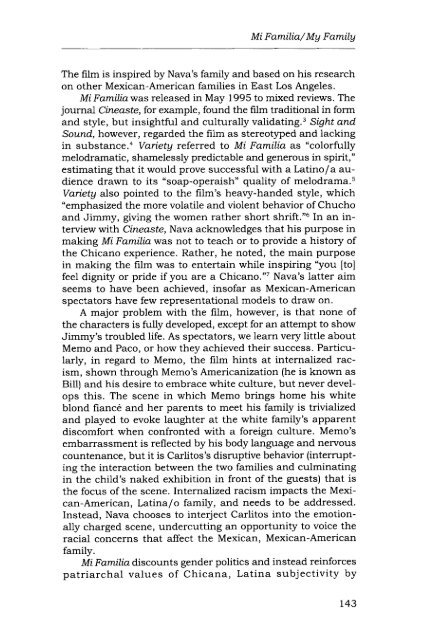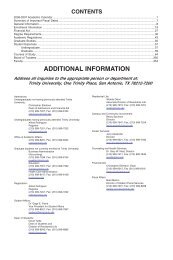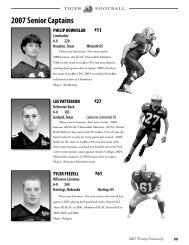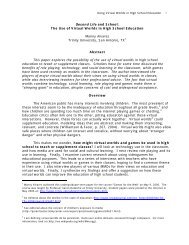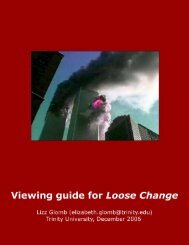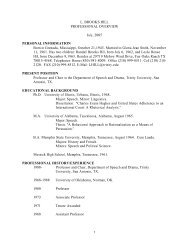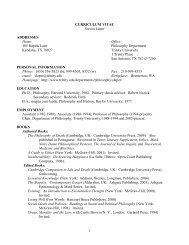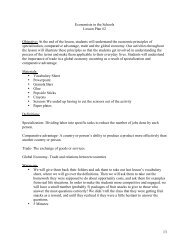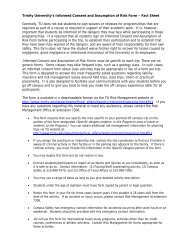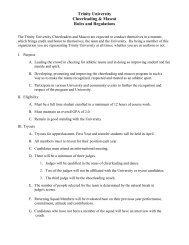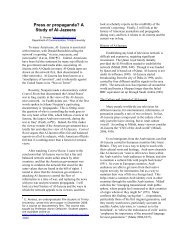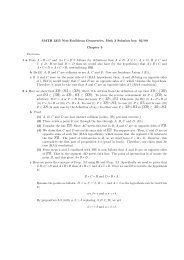Reviews - Trinity University
Reviews - Trinity University
Reviews - Trinity University
Create successful ePaper yourself
Turn your PDF publications into a flip-book with our unique Google optimized e-Paper software.
Mi Familia/My Family<br />
The film is inspired by Nava’s family and based on his research<br />
on other Mexican-American families in East Los Angeles.<br />
Mi Familia was released in May 1995 to mixed reviews. The<br />
journal Cineaste, for example, found the film traditional in form<br />
and style, but insightful and culturally ~alidating.~ Sight and<br />
Sound, however, regarded the film as stereotyped and lacking<br />
in ~ubstance.~ Variety referred to Mi Familia as “colorfully<br />
melodramatic, shamelessly predictable and generous in spirit,”<br />
estimating that it would prove successful with a Latino/a audience<br />
drawn to its “soap-operaish” quality of rnel~drama.~<br />
Variety also pointed to the film’s heavy-handed style, which<br />
“emphasized the more volatile and violent behavior of Chucho<br />
and Jimmy, giving the women rather short shrift.”6 In an interview<br />
with Cineaste, Nava acknowledges that his purpose in<br />
making Mi Familia was not to teach or to provide a history of<br />
the Chicano experience. Rather, he noted, the main purpose<br />
in making the film was to entertain while inspiring “you [to]<br />
feel dignity or pride if you are a chic an^."^ Nava’s latter aim<br />
seems to have been achieved, insofar as Mexican-American<br />
spectators have few representational models to draw on.<br />
A major problem with the film, however, is that none of<br />
the characters is fully developed, except for an attempt to show<br />
Jimmy’s troubled life. As spectators, we learn very little about<br />
Memo and Paco, or how they achieved their success. Particularly,<br />
in regard to Memo, the film hints at internalized racism,<br />
shown through Memo’s Americanization (he is known as<br />
Bill) and his desire to embrace white culture, but never develops<br />
this. The scene in which Memo brings home his white<br />
blond fiance and her parents to meet his family is trivialized<br />
and played to evoke laughter at the white family’s apparent<br />
discomfort when confronted with a foreign culture. Memo’s<br />
embarrassment is reflected by his body language and nervous<br />
countenance, but it is Carlitos’s disruptive behavior (interrupting<br />
the interaction between the two families and culminating<br />
in the child’s naked exhibition in front of the guests) that is<br />
the focus of the scene. Internalized racism impacts the Mexican-American,<br />
Latinalo family, and needs to be addressed.<br />
Instead, Nava chooses to interject Carlitos into the emotionally<br />
charged scene, undercutting an opportunity to voice the<br />
racial concerns that affect the Mexican, Mexican-American<br />
family.<br />
Mi Familia discounts gender politics and instead reinforces<br />
patriarchal values of Chicana, Latina subjectivity by<br />
143


